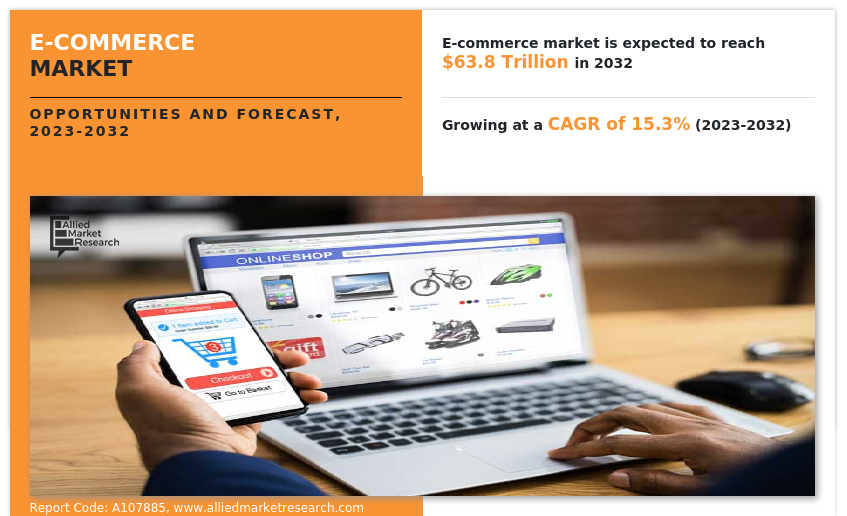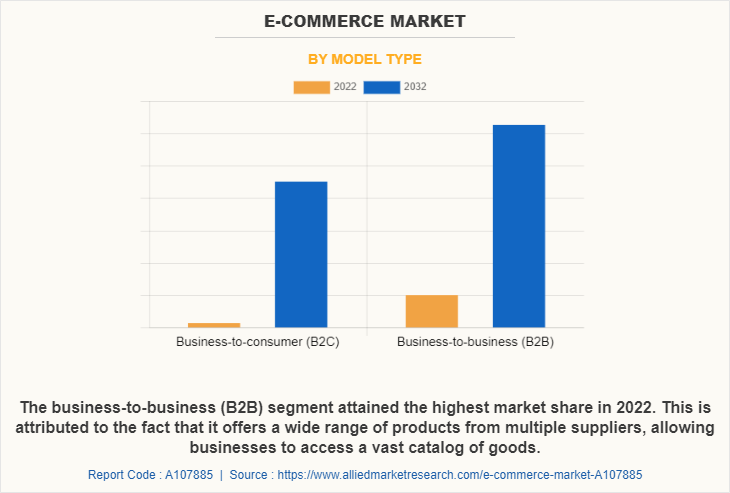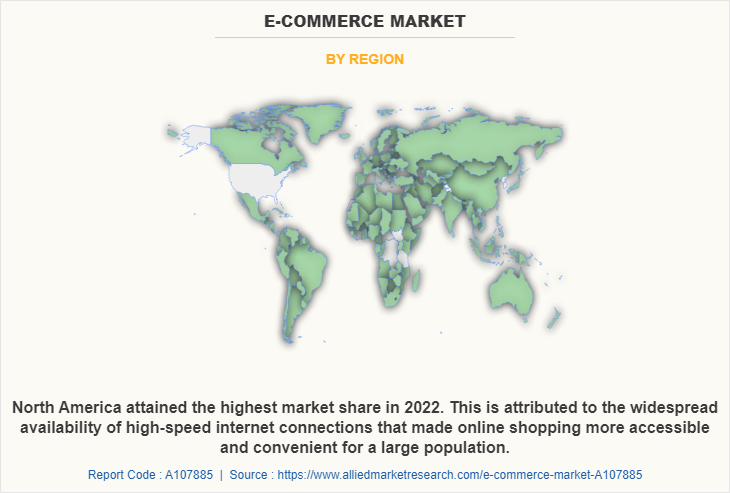E-commerce Market Research, 2032
The global e-commerce market was valued at $15.7 trillion in 2022, and is projected to reach $63.8 trillion by 2032, growing at a CAGR of 15.3% from 2023 to 2032.
E-commerce (or electronic commerce) is the process of buying and selling goods or services via the internet. Through websites, online marketplaces, and social media, individuals and businesses can sell goods and services using digital means to accept payment and collect customer data.

Furthermore, e-commerce platforms employ algorithms and data analysis to personalize the shopping experience. By analyzing customer preferences, purchase history, and browsing behavior, platforms can provide personalized product recommendations, tailored offers, and targeted marketing campaigns. Moreover, with the widespread use of smartphones and tablets, e-commerce has expanded to include mobile commerce.
The widespread availability and affordability of internet access have enabled more people to connect online. As internet penetration continues to increase globally, more individuals have access to online shopping platforms, leading to a larger customer base for e-commerce businesses. Furthermore, with the growth of international shipping and logistics, consumers can access products from around the world. This expansion of cross-border trade has significantly contributed to the growth of the e-commerce market. Moreover, the COVID-19 pandemic significantly accelerated the growth of the e-commerce market. The pandemic forced many traditional businesses to rapidly adopt or expand their e-commerce presence, contributing to the overall growth of the e-commerce industry. Therefore, these factors notably promote the growth of the e-commerce market.
However, trust and security issues are significant barriers to e-commerce market growth. Further, e-commerce relies on an efficient logistics network to deliver products to customers. Thus, inadequate infrastructure and logistical challenges can limit the growth of the e-commerce market, particularly in geographically dispersed or remote areas. On the contrary, the advancement of technology, especially in terms of mobile devices and internet connectivity, has played a crucial role in the growth of the e-commerce market.
Further, cross-border e-commerce that allows consumers to purchase products from overseas sellers is expected to create lucrative opportunities for the growth of the e-commerce market in the upcoming years. Improvements in logistics, payment systems, and international trade policies are facilitating the growth of cross-border e-commerce. The increasing demand for international products and the rise of platforms such as Alibaba's AliExpress and Amazon Global further contribute to this trend.
The report focuses on growth prospects, restraints, and trends of the e-commerce market forecast. The study provides Porter’s five forces analysis to understand the impact of various factors such as bargaining power of suppliers, competitive intensity of competitors, threat of new entrants, threat of substitutes, and bargaining power of buyers on the e-commerce market outlook.
Segment Review
The e-commerce market is segmented into model type, offering, and region. By model type, the market is differentiated into business-to-business (B2B) and business-to-consumer (B2C). Depending on offering, it is fragmented into beauty and personal care products, consumer electronics, fashion and apparel, household products, and others. Region wise, the E-commerce market is segmented into North America, Europe, Asia-Pacific, and LAMEA.

By model type, the business-to-business (B2B) segment acquired a major share. B2B e-commerce platforms enable businesses to streamline their procurement processes and reduce costs. By automating order placement, invoicing, and inventory management, businesses can achieve operational efficiencies and cost savings. Furthermore, it offers a wide range of products from multiple suppliers, allowing businesses to access a vast catalog of goods. This enables them to find the right products that meet their specific needs without the limitations of geographical boundaries. Thus, these factors drive the growth of the business-to-business (B2B) segment.
However, the business-to-consumer (B2C) segment is attributed to be the fastest-growing segment during the forecast period. This is attributed to the fact that the B2C model enables businesses to reach a global audience. E-commerce platforms allow companies to sell their products or services to customers around the world, breaking the geographical barriers of traditional retail. This opens new markets and customer segments, expanding the business potential.

Region wise, Asia-Pacific dominated the E-commerce market in 2022. This was attributed to the result of the rising adoption of smartphones, growing middle class and disposable income, and cross-border trade and globalization. Furthermore, the widespread adoption of smartphones has played a crucial role in the growth of the e-commerce market in Asia-Pacific. Smartphones offer convenient access to online shopping platforms, allowing consumers to shop anytime and anywhere. However, LAMEA is considered to be the fastest-growing region during the forecast period. The LAMEA region has witnessed significant urbanization, with people moving from rural areas to cities. Urban dwellers have easier access to the internet and tend to adopt new technologies and shopping habits more quickly. This shift in consumer behavior towards online shopping has fueled the growth of the e-commerce market.
The key players operating in the e-commerce market include Amazon.com, Inc., JD.com, Inc., Flipkart.com, Alibaba Group Holding Limited, Walmart Inc., Shein, Wayfair LLC, eBay Inc., Shopify, and pinduoduo.com. These players have adopted various strategies to increase their market penetration and strengthen their position in the industry.
Country-specific Statistics & Information
E-commerce has facilitated cross-border trade, allowing consumers to purchase products from international markets. The rise of platforms such as Alibaba's AliExpress and JD.com's JD Worldwide has enabled consumers to access a wide range of products from around the world. Similarly, international e-commerce giants such as Amazon have expanded their presence in the Asia-Pacific region to tap into the growing demand for cross-border shopping. For instance, in January 2021, Amazon launched Amazon Global Selling Propel (AGSP), an initiative designed to provide dedicated support to emerging Indian brands and startups to reach customers around the world. Amazon has partnered with Startup India to launch an accelerator program to help early-stage startups in the consumer products space to launch in international markets and create global brands from India through Amazon’s Global Selling program.
In addition, technological advancements, such as artificial intelligence (AI), big data analytics, and machine learning (ML), have transformed the e-commerce landscape. These technologies are being leveraged by key players to enhance the customer experience, personalize recommendations, optimize supply chain management, and improve logistics and delivery. For instance, Alibaba has adopted AI and machine learning algorithms to power its personalized shopping recommendations, while Lazada (an e-commerce platform in Southeast Asia) has used big data analytics to gain insights into consumer behavior and preferences.
The COVID-19 pandemic has had a positive impact on the e-commerce market size. With lockdowns and social distancing measures in place, consumers turned to online platforms to fulfill their shopping needs. This resulted in a surge in online shopping across various product categories, including groceries, electronics, and apparel. Furthermore, the pandemic forced many people who had never shopped online before to try e-commerce for the first time. This led to a substantial increase in the number of new online shoppers and expanded the overall customer base for e-commerce companies. In addition, the pandemic witnessed the emergence of new e-commerce models and trends. For instance, there was significant growth in online food delivery services, subscription-based models, and online marketplaces connecting local businesses with consumers. These new models expanded the e-commerce market and provided additional opportunities for growth.
Top Impacting Factors
Increase in Internet Penetration
The widespread availability and affordability of internet access have enabled more people to connect online. As internet penetration continues to increase globally, more individuals have access to online shopping platforms, leading to a larger customer base for e-commerce businesses.
In addition, key market players have targeted regions with increasing internet penetration, either through partnerships with local players or by establishing their own presence in those markets. They invest in digital marketing and advertising to reach out to these new internet users. For instance, in January 2021, Amazon launched Amazon Global Selling Propel (AGSP), an initiative designed to provide dedicated support to emerging Indian brands and startups to reach customers around the world. Amazon has partnered with Startup India to launch an accelerator program to help early-stage startups in the consumer products space to launch in international markets and create global brands from India through Amazon’s Global Selling program. Therefore, the expansion of internet connectivity across the globe has been a significant driver of e-commerce market growth.
Social Media and Influencer Marketing
Social media platforms have become powerful marketing channels, allowing e-commerce businesses to reach a broader audience and engage with potential customers. Influencer marketing, where social media influencers promote products and brands, has proven to be an effective strategy to drive e-commerce growth by leveraging the trust and influence of popular personalities. For instance, in June 2022, Walmart and Roku, Inc. announced a partnership to make TV streaming the next e-commerce shopping destination. Walmart has become the exclusive retailer to enable streamers to purchase featured products fulfilled by Walmart directly on Roku, America’s number one TV streaming platform. Therefore, the expansion of internet connectivity across the globe has been a significant driver of market growth.
Technological Advancements
The advancement of technology, especially in terms of mobile devices and internet connectivity, has played a crucial role in the growth of the e-commerce market. The widespread use of smartphones and tablets, along with faster internet speeds, has made it easier for consumers to shop online. In addition, key market players have adopted various strategies to leverage these advancements, such as developing mobile apps and optimizing their websites for mobile devices. They also invest in technologies such as artificial intelligence (AI) and machine learning (ML) to personalize the shopping experience and enhance customer engagement. For instance, in July 2021, Fanlunke Supply Chain Management (Shanghai) Co., Ltd, a controlled affiliate of the Nisun International Enterprise Development Group Co., Ltd, signed a partnership agreement with Beijing Jingdong Century Information Technology Co., Ltd, a subsidiary of JD.com, China's leading technology-driven e-commerce company transforming to become a leading supply chain-based technology and service provider. Under this agreement, the two groups entered into joint cooperation to develop supply chain services targeting the e-commerce industry.
Cross-border E-commerce
Cross-border e-commerce allows consumers to purchase products from overseas sellers, providing access to a broader range of products and often at competitive prices. Improvements in logistics, payment systems, and international trade policies are facilitating the growth of cross-border e-commerce. The increasing demand for international products and the rise of platforms such as Alibaba's AliExpress and Amazon Global further contribute to this trend.
In addition, key players adopt various strategies to provide major growth opportunities to the market. For instance, in April 2021, JD Global Sales under JD.com, and Visa Inc., the world’s leader in digital payments, signed an agreement to deepen cooperation in cross-border e-commerce. Under this partnership, JD Global Sales and Visa agreed to jointly launch an online merchant subsidies program, targeting consumers across Hong Kong, Macau, Taiwan, and overseas markets. The program aims at facilitating the overseas expansion of Chinese brands and merchants, helping them recover from the COVID-19 epidemic at a faster pace with optimized cross-border products and services, as well as driving cross-border e-commerce growth post the pandemic. Therefore, this factor is expected to provide lucrative growth opportunities for the e-commerce market.
Report Coverage & Deliverables
The e-commerce market report provides comprehensive coverage of key industry dynamics, including changes in e-commerce policy, technological advancements, and consumer behavior shifts. It delves into the impact of e-commerce companies on global retail, challenges in the e-commerce domain, and opportunities for growth. The report includes data on e-commerce adoption, market size, growth projections, and competitive strategies, addressing both e-commerce challenges like regulatory compliance and cybersecurity risks.
Type Insights
The e-commerce market includes various types of services:
Business-to-Consumer (B2C): Dominates the market, driven by the growth of online retail platforms in e-commerce.
Business-to-Business (B2B): Growing rapidly, as companies adopt digital solutions for procurement and distribution.
Technology Insights
Technologies like AI and Blockchain are transforming the e-commerce domain, enabling personalized shopping experiences and secure payment systems. Cloud computing also plays a crucial role in scaling e-commerce services to meet rising consumer demand and drive E-commerce growth.
Application Insights
E-commerce applications are widely used for online retail, digital banking, and logistics. The e-commerce share is expanding across various sectors as businesses integrate digital platforms to improve operational efficiency and customer reach.
Regional Insights
North America and Europe dominate the e-commerce value, driven by high internet penetration and tech-savvy consumers.
Asia-Pacific is the fastest-growing region, fueled by increasing smartphone usage and a surge in e-commerce adoption across emerging markets like India and Southeast Asia.
Key Companies & Market Share Insights
Major e-commerce companies include Amazon, Alibaba, and Shopify, leading the market with innovative services and broad consumer bases. Their ability to adapt to regulatory shifts and leverage technology contributes to their significant e-commerce market share.
Key Benefits for Stakeholders
- This report provides a quantitative analysis of the market segments, current trends, estimations, and dynamics of the e-commerce market analysis from 2022 to 2032 to identify the prevailing e-commerce market opportunity.
- The market research is offered along with information related to key drivers, restraints, and opportunities.
- Porter's five forces analysis highlights the potency of buyers and suppliers to enable stakeholders to make profit-oriented business decisions and strengthen their supplier-buyer network.
- In-depth analysis of the e-commerce market segmentation assists to determine the prevailing e-commerce market opportunities.
- Major countries in each region are mapped according to their revenue contribution to the e-commerce market share.
- Market player positioning facilitates benchmarking and provides a clear understanding of the present position of the market players.
- The report includes the analysis of the regional as well as e-commerce market trends, key players, market segments, application areas, and market growth strategies.
E-commerce Market Report Highlights
| Aspects | Details |
| Market Size By 2032 | USD 63.8 trillion |
| Growth Rate | CAGR of 15.3% |
| Forecast period | 2022 - 2032 |
| Report Pages | 225 |
| By Model Type |
|
| By Offering |
|
| By Region |
|
| Key Market Players | Walmart Inc., ALIBABA GROUP HOLDING LIMITED, JD.com, Inc., eBay Inc., Flipkart, Amazon.com Inc., Shopify, Wayfair LLC, Shein, pinduoduo.com |
Analyst Review
E-brokerages provide investors with a modern, convenient, cost-effective, and knowledgeable way to trade and monitor their investments. By using an e-brokerage, investors have access to online trading software. Each broker generally has a unique trading platform that is used by their customers where there are real-time price quotes on stocks, mutual funds, exchange-traded funds (ETFs), currencies, commodities, or any other type of investment that is supported by the broker. The investor can usually access sought-after information easily in order to research investment options before making a decision.
In addition, the rise of automated investment solutions and robo-advisory services has contributed to the growth of the e-brokerage market. Robo-advisors use algorithms and artificial intelligence to provide personalized investment recommendations and manage portfolios automatically. This automated approach appeals to investors looking for low-cost and hands-off investment management.
The COVID-19 outbreak has had a moderate impact on the e-brokerage market. The pandemic led to a surge in retail trading activity as individuals sought alternative investment opportunities and sources of income. E-brokerage providers capitalized on this trend by enhancing their platforms and offerings to cater to the growing demand. They focused on user-friendly interfaces, educational resources, and simplified trading processes to attract and retain retail investors.
The E-brokerage market is fragmented with the presence of regional vendors such Charles Schwab & Co., FMR LLC, E*TRADE, Interactive Brokers LLC, eToro, FP Markets, eOption, tastytrade, Inc., XTB, and TD Ameritrade. Major players operating in this market have witnessed significant adoption of strategies that include business expansion and partnership to reduce supply and demand gap. With the increase in awareness & demand for e-brokerage across the globe, major players are collaborating their product portfolio to provide differentiated and innovative products.
By the end of 2032, the market value of E-commerce Market will be $63,800.16 billion.
Increase in internet penetration Social media and influencer marketing Technological advancements Cross-border e-commerce
The key players operating in the e-commerce market include Amazon.com, Inc., JD.com, Inc., Flipkart.com, Alibaba Group Holding Limited, Walmart Inc., Shein, Wayfair LLC, eBay Inc., Shopify, and pinduoduo.com.
The e-commerce market is segmented into model type, offering, and region. By model type, the market is differentiated into business-to-business (B2B) and business-to-consumer (B2C). Depending on offering, it is fragmented into beauty and personal care products, consumer electronics, fashion and apparel, household products, and others. Region wise, the market is segmented into North America, Europe, Asia-Pacific, and LAMEA.
Loading Table Of Content...
Loading Research Methodology...



